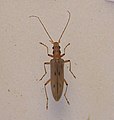
The longhorn beetles (Cerambycidae), also known as long-horned or longicorns, are a large family of beetles, with over 35,000 species described. Most species are characterized by extremely long antennae, which are often as long as or longer than the beetle's body. In various members of the family, however, the antennae are quite short and such species can be difficult to distinguish from related beetle families such as the Chrysomelidae. The scientific name of this beetle family goes back to a figure from Greek mythology: after an argument with nymphs, the shepherd Cerambus was transformed into a large beetle with horns.

The family Oedemeridae is a cosmopolitan group of beetles commonly known as false blister beetles, though some recent authors have coined the name pollen-feeding beetles. There are some 100 genera and 1,500 species in the family, mostly associated with rotting wood as larvae, though adults are quite common on flowers. The family was erected by Pierre André Latreille in 1810.

Odiniidae is a small family of flies. There are only 58 described species but there are representatives in all the major biogeographic realms.
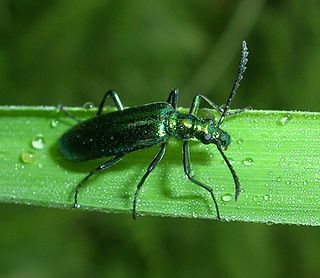
Prionoceridae is a small family of beetles, in the suborder Polyphaga. They form a group within the cleroid beetles and were formerly treated as a subfamily (Prionocerinae) within the family Melyridae. Very little is known of their life history but most species are pollen feeders as adults and occur in large numbers during spring or the host flowering season. Larvae are predatory or feed on decomposing wood.
Crioprosopus is a genus of long-horned beetles in the family Cerambycidae. There are about 13 described species in Crioprosopus.
Crioprosopus thoracicus is a species of long-horned beetle in the family Cerambycidae. It was described by Henry Walter Bates in 1892.

Elonus is a genus of ant-like leaf beetles in the family Aderidae. There are about seven described species in Elonus in North America.
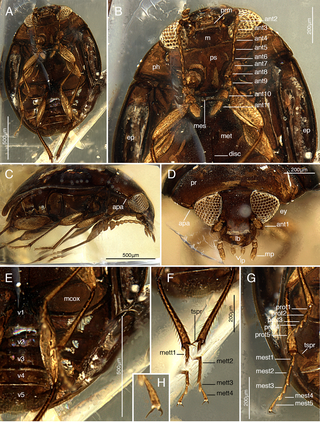
Cyclaxyridae are a family of beetles in the superfamily Cucujoidea. The only living genus is Cyclaxyra, with two species endemic to New Zealand. Other species have been named from fossils. They are also known as sooty mould beetles due to the association of Cyclaxyra with sooty mould. The extant species are mycophagous, feeding on spores, conidia, and hyphae.

Neobidessodes is a genus of predaceous diving beetles in the family Dytiscidae. There are about 10 described species in Neobidessodes. They are found in Australasia. The genus was first described in 2009, and the type species is N. denticulatus.
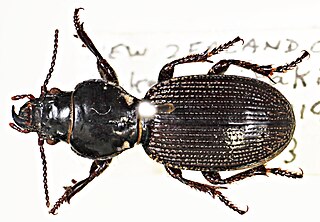
Mecodema aberrans is a medium-sized ground beetle endemic to the South Island, New Zealand. This species is within the curvidens group and is one of three species that is a braided-river ecotype. It occurs in Otago and Canterbury.

Ischnomera is a genus of false blister beetles in the subfamily Oedemerinae.
This paleoentomology list records new fossil insect taxa that were to be described during the year 2021, as well as notes other significant paleoentomology discoveries and events which occurred during that year.
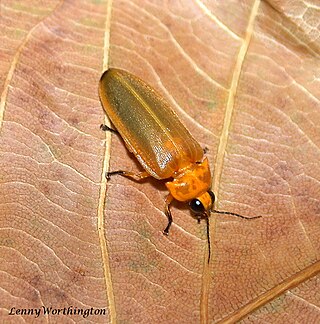
Pteroptyx is a genus of fireflies in the subfamily Luciolinae found in Southeast Asia. It has long been noted for the ability to perform synchronous flashing, though not all species synchronize. These synchronizing species have been found on so-called 'firefly trees' and created a growing firefly-watching tour industry in some regions. Species of the genus have been identified in Malaysia, Thailand, the Philippines, and Hong Kong.

Parisopalpus nigronotatus, known by its common name, the spotted lax beetle, is a species of false blister beetles. It was first identified by Carl Henrik Boheman in 1858, under the name Nacerdes nigronotata. Native to eastern Australia, the species was introduced to New Zealand in 1931.


